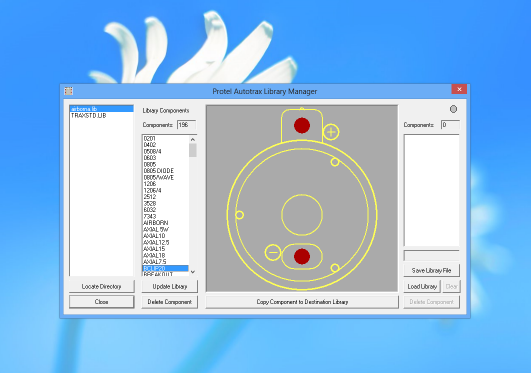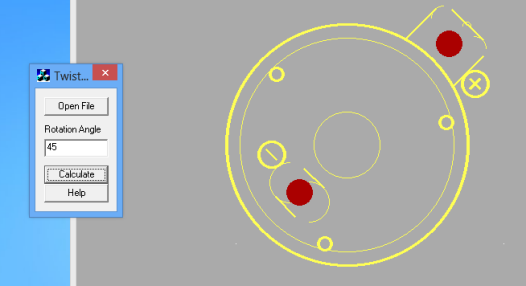Richard Aston's Autotrax Utilities

Protel Autotrax Library Manager
One difficulty with Protel Autotrax is with the handling of Libraries. Libraries in Autotrax are limited to 200 components. It is normal to have a number of libraries to complete a job - and copying parts in and out of libraries is difficult - it is not handled especially well within Autotrax.
Enter Richard Astons Library Manager. This utility makes it straightforward to search for parts in several libraries. A list of library parts is shown, and as you go down the list each part is displayed in the center panel. It is easy to copy parts from one library to another. And the utiltity runs under all modern windows OS versions (the image to the right shows librarywiz4 running under windows 8).

Circular Pads array
ArrayMaker produces arrays of circular pads in Autotrax format. The values are entered on the single input panel as shown, then the result is produced as a file called 'Output.PCB'. Every time 'Create' is clicked, an array with the parameters provide is appended to the PCB.
While you could take this PCB and build the rest of your board around it, you can more usefully use 'Block Read' from within Autotrax, and place the array of circular pads onto an existing PCB, or, for instance, put a legend and other details on it and save it as a component.
Arraymaker is provided open source, all code is included in the package. It runs under all modern versions of windows, and is shown to the right running under Windows 8 with a copy of its ouptut viewed in Autotrax (also under Windows 8, using DOSBox) to the right.

Grounder32
Grounder32. This utility duplicates the chosen source layer onto the destination layer whilst enlarging the track by the user-specified width. This value is clearance; so an enlargement of, say, 10mil applied to a 20mil track would produce a 40mil result.
Select the check boxes at the top to select either power plane, ground plane, or both. The select the source layer for each, enter the required enlargements and click 'Run'.
The resultant file is the source file with the first letter replaced by an underscore. So 'blob.pcb' becomes "_lob.pcb'.

Twist32
Twist32 rotates components or boards by a selectable amount. To rotate a component, first save it as a PCB, (using block write) then block read the result back in. The result will be written to 'Output.PCB'.
Twist32 is limited by the Autotrax format itself in two particular ways: Partial arcs and fills. Partial arcs may be generated in Autotrax with any of four quadrants in place - NE,SE,SW,NW. There is no provision for any other type of arc, particularly not one which begins or ends at a certain number of degrees other than 0, 90, 180 or 270. Therefore it is not possible to rotate partial quadrant arcs by, say, 45 degrees in the Autotrax format. All this means is that if your PCB or component does contain a few of these, you will need to do some clean-up afterwards - the utiltity has done the best job it can. With fills the utility does not carry them through to the result - it is for the same reason - the Autotrax format does not provide any way to rotate fills, as they are specified by X and Y positions and sizes, not the corner positions.
Twist32 will save you a lot of work, as you can take a tested component, twist it to an arbitary angle, and be reasonably certain when you make the PCB that the part will still slot into the board ... when you do this manually there is always the chance you will stuff up one of the calculations. Again, Twist23 can run under any recent Windows OS.

DCoder
DCode32 Richard Aston's utility 'DCoder' which generates Gerber file aperture lists from an Input PCB file.
Disclaimer: These utilities are provided in good faith, but with no warranty. Source code is provided to enable you to modify or repair the utilities if you desire. Written by Richard Aston: www.richard-aston.co.uk
- Contact Us
- Enquiry Form
- Sitemap
- The PCB design method
- About Circuit diagrams
- About PCB layout
- About Firmware design
- Spec'ing your job
- Our design service
- Autotrax PCB on Win8
- Autotrax VESA Drv
- Autotrax Resources
- Autotrax Library
- Autotrax Useage
- Autotrax Printer Drv
- Autotrax XP Driver
- 6 layer Autotrax PCB
- Autotrax Utilities
- Autotrax File format
- Autotrax Manual
- Autotrax Tutorial
- Example Projects Library
- Mechatronic control unit
- Garbage truck compactor
- RS232-RS485 convert (2006)
- Tone generator test project
- RS485 fire panel int.
- Front panel switches( A/D)
- Serial to IRDA
- Danfoss loop tester
- RAN Multilayer trainer
- Programmable Oscillator
- Pressure sense PCB
- Nursecall overdoor light V2
- Design step-by-step
- Circuit diagrams
- PCB Layout
- PCB Etching
- Prototyping
- Firmware design
- Documentation
- Manufacturing
- Economies of scale
- Test Procedures
- ECOs - changes
- EMI & ESD in design
- FR4 and fire resistance
- Project Specifications
- Specification Intro.
- Writing a Spec
- Tech Ingredients
- Example Specs (older)
- Selecting a designer
- R&D Economics
- Design Inspiration
- Autotrax Utitilities
- Autotrax links
- Our PicoBus IO Std
- RS232 connectors
- Our RS485 converter
- P89LPC932
- Our Program header
- How to use a Multimeter
- Our Site index
- Offsite Links (15000+)
- Google search
- Contact
©2013 AirBorn - Last updated 01 May 2013